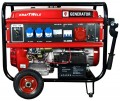Output voltage
Nominal voltage at the generator output.
—
230 V Standard voltage of a regular household socket. It is widely used in everyday life, and there are many 230 V devices among specialized equipment; the only exception is powerful equipment (mainly from 4-5 kW), for which this voltage is no longer enough. It is 230-volt generators that should be considered by tech looking for a device for backup power supply of a residential premises or a small office.
—
400 V Generators capable of delivering three-phase power with a voltage of 400 V. Such power is extremely rarely used in everyday life, but it may be required for heavy equipment, specialized tools and other similar loads. Generators with an output voltage of 400 V are generally more powerful, heavier, larger, more expensive and more "gluttonous" than 230-volt ones. It is worth specifically looking for such a unit only in cases where the presence of three-phase power is essential.
—
230 and 400 V Combined power supply models — most generators with a three-phase output voltage of 400 V are also equipped with single-phase 230 V sockets. This ensures their universal use both for backup power supply of a home or office, and for performing more resource-intensive tasks (for example, in construction and repair, for autonomous operation of high-power loads, etc.).
— 110 V. Generators with 110
...V sockets (or 120 V for certain regions). This voltage is found in household electrical networks in some countries of North and Central America, Japan, Saudi Arabia, and occasionally in Great Britain. It is not recommended to connect 230 V equipment to such sockets (unless otherwise specified in the technical documentation for a specific electrical appliance).
— DC (48 V). Models with one or more DC connectors for powering external devices with direct current. The standard DC socket is round and has a pin in the center, but its depth and diameter may vary. The voltages output to the DC output may vary — in this case, 48 V is implied.Fuel tank volume
The volume of the fuel tank installed in the generator.
Knowing the fuel consumption (see above) and the capacity of the tank, you can calculate the operating time on one gas station (if it is not indicated in the specifications). However, a more capacious tank is also more bulky. Therefore, manufacturers choose tanks based on the general level and "voracity" of the generator — in order to provide an acceptable operating time without a significant increase in size and weight. So in general, this parameter is more of a reference than practically significant.
As for the numbers, in low-power models, tanks are installed for
5 – 10 liters, or even
less ; in heavy professional equipment, this figure can
exceed 50 liters.
Total number of sockets
The total number of sockets for 230 and/or 400 V provided in the design of the generator.
This number corresponds to the number of devices that can be simultaneously connected to the generator without using splitters, extension cords, etc. If it is a three-phase model (see "Output voltage") with different types of sockets, it is worth specifying the quantity of each type separately, as different models may have varying configurations. For example, a unit specified as having
3 sockets might have 1 three-phase socket and 2 single-phase ones, or 2 three-phase and 1 single-phase socket. Generally, the most basic modern generators have only
1 socket, though models with
2 sockets are more common; and the most powerful models can have
4 or more sockets.
It is also important to remember that the ability to connect various devices is limited not only by the number of sockets but also by the generator's rated power (see above for more details).

